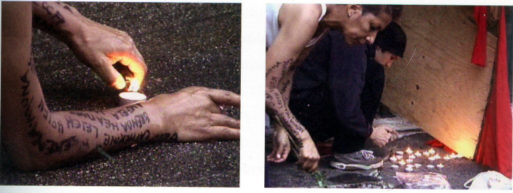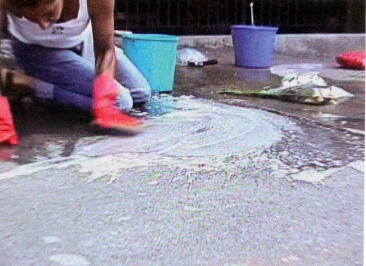
Still from “Vigil” by Rebecca Belmore
(Credit: notartomatic.files.wordpress.com)
We all have different ideas that spring to mind when we hear the word “ritual.” Some of us immediately see in the mind’s eye the titillating Hollywood version, with dim candle-lit rooms and voices rhythmically reciting words in a language known only to initiates. On the other hand, many of us feel cozily at home remembering the familiar traditions of our families. And then there are those who look for a ritual to honor something important in their lives — a way of marking life’s changes in a meaningful way — and come up empty-handed. Some of those seekers create new rituals in the vein of older traditions. We call these ceremonialists for modern times “artists.” Rebecca Belmore is one such person.

Still from “Vigil.” Rebecca Belmore reads then shouts aloud the names of missing and murdered women written on her arms.
(Credit: einsights.ogpr.educ.ubc.ca)
In 2002, Belmore shared a piece called “Vigil,” as part of the Talking Stick Festival in Vancouver, British Columbia, Canada, within the unceded and illegally occupied territory of the Coast Salish peoples. “Vigil” was performed on a street corner in the Downtown Eastside, a neighborhood known widely as Canada’s “poorest postal code.” Among the many personal and systemic challenges facing the residents of this community are the social and economic conditions — among them, the legacy of multigenerational trauma resulting from Canada’s residential school system — that forces women into incredibly high-risk survival sex work. Belmore’s “Vigil” commemorates the murdered and missing women who continue to be ignored by the justice system today.
On behalf of the silent voices who suffer the untimely loss of their mothers, daughters, sisters, and best friends, Belmore offered the ritual of “Vigil” and her own authentic presence to witness the suffering caused by the disappearance of these forgotten women, and to be witnessed in her grief, which has no welcoming or safe space in the public domain.

Still from “Vigil”
(Credit: notartomatic.files.wordpress.com)
The ritual of “Vigil” comprises several intentional, methodical actions strung together much like words in a poem; each action has its own resonance, and gains layers of meaning within the context of each other. In this video of the performance, Belmore scrubs the street as if to purify it of its violent past; lights votive candles as a symbol of remembrance; repeatedly nails the red dress that she’s wearing to a telephone post, ripping it away in shreds; and subverts the tradition of bringing flowers to the bereaved by calling out the names of the murdered and missing women scrolled on her arms, then ripping blossoms and leaves from their stems with her teeth.

Still from “Vigil”
(Credit: coldcutsvideofestival.wordpress.com)
For a ritual to have a meaningful place in anyone’s life, it must have resonance for the person and function as a container within which transformation can occur. In “Vigil,” each aspect carried symbolic significance for Belmore, which witnesses might receive by connecting empathically with Belmore herself or through an understanding of the symbols Belmore utilized. Moreover, it can safely be assumed that Belmore’s personal experiences leading up to this performance created the necessity of this ritual. When she calls out the names of the missing and murdered women, and when she is tearing the nailed dress free, we witness the grief that needed this ritual to be expressed. We could all take a page from Belmore’s book by using the principles of ritual to create meaningful moments to mark important transitions in our lives.

 Performance Artist Uses Power of Ritual to Move Collective Grief
Performance Artist Uses Power of Ritual to Move Collective Grief


 Forest Bathing Eases Grief by Soaking in Nature
Forest Bathing Eases Grief by Soaking in Nature
 The Spiritual Symbolism of Cardinals
The Spiritual Symbolism of Cardinals
 Meaning-Focused Grief Therapy: Imaginal Dialogues with the Deceased
Meaning-Focused Grief Therapy: Imaginal Dialogues with the Deceased














